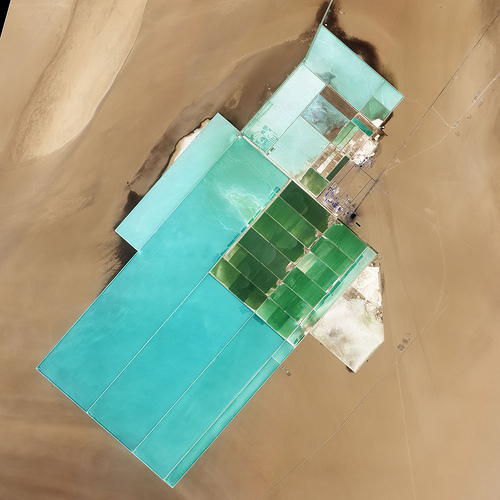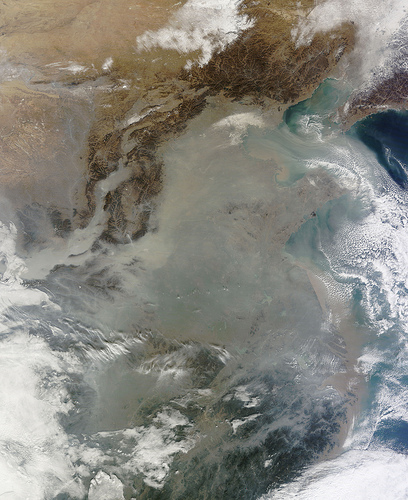A few good source china photos I found:
Lop Nur, Xinjiang, China

Image by NASA Goddard Photo and Video
NASA image acquired May 17, 2011
Situated in China’s resource-wealthy but moisture-poor Xinjiang autonomous area, Lop Nur is an uninviting location for any kind of agriculture. It sits at the eastern end of the Taklimakan Desert, where marching sand dunes can reach heights of 200 meters (650 feet), and dust storms rage across the landscape.
But for all it lacks in agricultural appeal, Lop Nur provides some thing worthwhile to farmers the planet more than: potash. This potassium salt offers a significant nutrient needed for plant growth, making it a crucial ingredient in fertilizer.
The discovery of potash at Lop Nur in the mid-1990s turned the location into a large-scale mining operation. The Advanced Land Imager (ALI) on NASA’s Earth Observing-1 (EO-1) satellite captured this all-natural-colour image of Lop Nur on Could 17, 2011. The rectangular shapes in this image show the bright colors characteristic of solar evaporation ponds. About the evaporation ponds are the earth tones standard of sandy desert.
For the duration of the early and middle Pleistocene epoch, this area held a huge brackish lake. Uplift of the northern element of the lake in the late Pleistocene designed hollows that became receptacles for potash deposition. The main potash deposits located at Lop Nur right now are brine potash, and this website is the second-biggest supply of potash in China.
Lop Nur gradually dried up in the Holocene. The region now receives average annual precipitation of just 31.two millimeters (1.two inches), and experiences annual evaporation of 2,901 millimeters (114 inches), according to a study published in 2008. The study discovered, nevertheless, that this region has knowledgeable seven main climate modifications because the finish of the Pleistocene, including climatic situations far far more favorable to farming and settlement than nowadays.
Examination of plant and mollusk remains at the lake, as properly as studies of sediments, indicate that the Lop Nur region experienced a extreme drought about three,000 years ago, followed by wetter situations. Amongst 1,250 and 400 years ago, Lop Nur probably knowledgeable the conditions most favorable to farming and settlement, and red willow trees grew in the location. Pottery dating from the Tang and Song dynasties additional testifies to welcoming situations at the lake centuries ago.
Beginning around 400 years ago, even so, a much more arid climate took hold, fully drying out Lop Nur. These days, by delivering potash, the desiccated lake nevertheless supports agriculture, but it does so for farming efforts additional afield.
NASA Earth Observatory image designed by Jesse Allen and Robert Simmon, employing EO-1 ALI information offered courtesy of the NASA EO-1 group. Caption by Michon Scott.
Instrument: EO-1 – ALI
Credit: NASA Earth Observatory
NASA Goddard Space Flight Center enables NASA’s mission through four scientific endeavors: Earth Science, Heliophysics, Solar System Exploration, and Astrophysics. Goddard plays a leading role in NASA’s accomplishments by contributing compelling scientific knowledge to advance the Agency’s mission.
Comply with us on Twitter
Like us on Facebook
Uncover us on Instagram
Haze over eastern China

Image by NASA Goddard Photo and Video
The skies over northern China were shrouded with a thick haze in late December, 2013. The Moderate Resolution Imaging Spectroradiometer (MODIS) aboard the Terra satellite captured this accurate-colour image on December 23.
The dense, gray haze obscures almost all the land and considerably of the coastal waters from view south and east of the Taihang Mountains. Clearer air covers the area north of the mountains, though fingers of haze roll by means of most river valleys. The cities of Beijing and Hebei, both west of the Bohai Sea are comprehensive enshrouded.
By December 24 the smog levels in some area exceeded Globe Well being Organization-recommended levels by 30 occasions, according to Bloomberg News. The concentration of PM2.5, which are fine air particulates, were reported at 421 micrograms per cubic meter at 2 p.m. near Tiananmen Square in Beijing, whilst levels were 795 in Xi’an and 740 in Zhengzhou. The World Health Organization (WHO) recommends 24-hour exposure to PM2.five concentrations no larger than 25 micrograms per cubic meter.
While not the sole trigger of haze and pollution, the use of coal as a really low-cost energy supply adds to the dilemma, particularly north of the Huai River. Prior to 1980, the government policy supplied free coal for fuel boilers for all individuals living north of the Huai River. The widespread use of coal enables people in the north to remain warm in winter, but they have paid a price in air high quality.
According to Michael Greenstone, a Professor of Environmental Economics at Massachusetts Institute of Technology (MIT), whose analysis group published a paper on sustained exposure to air pollution on life expectancy in the region, air pollution, as measured by total suspended particulates, was about 55% higher north of the Huai River than south of it, for a distinction of around 184 micrograms of particulate matter per cubic meter. The study, published in Proceedings of the National Academy of Sciences in July, 2013, also noted life expectancies have been about five.five years lower in the north, owing to an increased incidence of cardiorespiratory mortality.
Air pollution is an on-going problem for the government of China, and Beijing’s Five-Year Clean Air Action Plan aims to decrease general particle density by more than 25 % on the PM2.five scale by 2017, and also takes aim at shutting down all coal-burning plants.
Credit: NASA/GSFC/Jeff Schmaltz/MODIS Land Rapid Response Group
NASA Goddard Space Flight Center enables NASA’s mission by means of 4 scientific endeavors: Earth Science, Heliophysics, Solar Program Exploration, and Astrophysics. Goddard plays a major function in NASA’s accomplishments by contributing compelling scientific knowledge to advance the Agency’s mission.
Follow us on Twitter
Like us on Facebook
Uncover us on Instagram